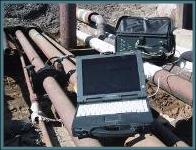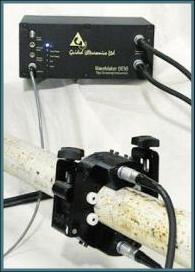

|
Guided Waves |
|
Equipment Performance
· Low voltage, battery operated
· Range on straight pipes is typically 25 meters on either side of the transducer ring but can be as high as 100 meters in ideal conditions.
· Only a 3-inch clearance is needed around the pipe.
· On-line interactive reporting.
· Operates on pipes from 2 to 24 inches in diameter.
· Pipe diameters above 24 inch can be tested by linking inflatable rings together.
· Option to use multiple types of guided waves modes.
· Software assisted feature recognition.
· Intelligent transducer ring design allows the computer to uniquely recognise the probe arrays attached to it and adjusts the test parameters appropriately.
· New generation transducers provide wide frequency range and extend the maximum inspection range.
· Test times can be as low as 1 minute for 25 meters in both direction although this can vary depending on test parameters.
· Wavemaker G3 achieves better range and sensitivity compared to the previous Wavemaker SE16 instrument, especially in the most challenging applications such as testing in noisy environments (for example offshore) and testing coated pipes (for example road crossings). This is due to substantial improvements in sampling resolution and filtering together with an additional high voltage output capability.
· New features in the electronics provide better system reliablilty, direct data storage within the instrument, and improved connectivity. The new WaveProG3 software, based on the proven WavePro algorithms, offers new straight-forward analysis options and automatic routines that greatly improve productivity and the quality of the presented results. These improvements make the equipment more user-friendly.
The Wavemaker G3 is designed to be compatible with all testing tools previously designed by GUL. It offers, however, more channels and new options for future planned developments |
|
The Wavemaker G3 Pipe Screening System is designed for rapid screening of long lengths of pipe to detect external or internal corrosion as well as axial and circumferential cracking. It can be used on a wide variety of pipes including those that are buried or insulated. A wide range of innovative features has been incorporated into the Wavemaker Pipe Screening System and a user-friendly interface ensures that it is easy to use. The test can be done while the plant is operating so disruption is minimised. Hundreds of metres of pipe can be inspected in a day and 100% of the pipe wall is inspected during a test. The Wavemaker Pipe Screening System is an efficient and effective method of screening. |
|
Specialized Inspections Co. Ltd. is providing Guided waves services on pipes using the Wavemaker G3 which is the latest generation of pipe screening systems. |
|
The Wavemaker Pipe Screening System uses a new two-ring array of probes rather than three as used in earlier applications of this technology. This has proven to be highly effective in terms of its ability to detect the presence of corrosion but with reduced equipment capital cost. The probe arrays can be attached to the pipe in less than one minute. |
|
Two types of guided waves (longitudinal and torsional) are used to broaden the range of possible frequencies and to adjust for different situations, for example the presence of liquids. Axi-symmetric and non-axi-symmetric waves aid in defect detection and interpretation of the results. All aspects of the system, the electronics, software, probes and the clamping arrangements are designed and manufactured in-house.
In conventional thickness gauging, the wall thickness is measured only at the position immediately below the transducer. The Wavemaker Pipe Screening System uses low frequency guided ultrasonic waves that propagate along the pipe wall. Transducers attached to the pipe send waves tens of metres along the pipe wall and the returning echoes indicate defects and other features. Access is only needed at the |
|
transducer position and the waves will propagate under insulation and other coatings. The inspection can be performed while the pipe is still in service, even if the pipe is filled with fluid or is operating at an elevated temperature.
Long lengths of pipe are therefore examined from one location which allows difficult to inspect areas, such as roadways, to be screened with ease.
A test that uses the Wavemaker Pipe Screening System is carried out in three steps:
· A ring of transducers is placed around the pipe · Guided waves are sent in each direction
Reflections are analysed separately for each of the two directions Small pipes with a diameter of 2-8 inches are tested using solid rings which can be mounted in less than a minute and requires a clearance of only 3 inches around the pipe. Large pipes with a diameter of 8-24 inches are tested using an inflatable ring. |
|
There are many advantages of using the Wavemaker Pipe Screening System for rapid long-range pipe screening: |
|
· The test can be carried out at elevated temperatures without taking the pipe out of service.
· 100% of the pipe is inspected (within the diagnostic length of a test).
· Pulse echo type operation provides information on feature position and severity.
· Sophisticated analysis aids interpretation of results.
· Interpretation possible between defects and standard pipe features.
· Ability to detect metal loss and planar defects at long range.
· Metal loss may be internal or external.
|

|
· Sensitivity can be as good as 2% loss of cross-section in ideal conditions (but is typically set at 10%). |
|
These performance capabilities are typical for the majority of pipe systems. However pipe systems can vary greatly in design and condition, and this affects inspectability. For example, bitumen wrapping greatly reduces the test range and sections of pipes with numerous features (e.g. several T’s collected together) cannot be tested reliably. Well-trained operators are required for interpretation of the results.
The system has been designed to operate as a screening tool that can quickly identify problem areas. When the pipe is accessible, it is frequently recommended that a detailed inspection (using complementary techniques) is performed at any identified corrosion areas. |




